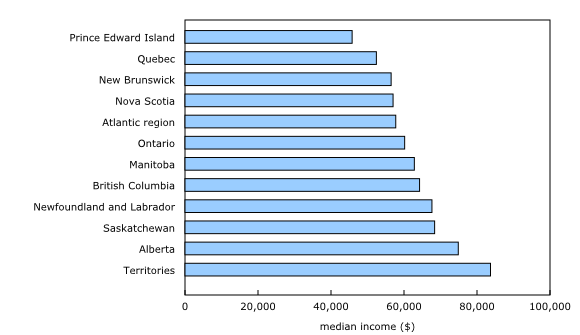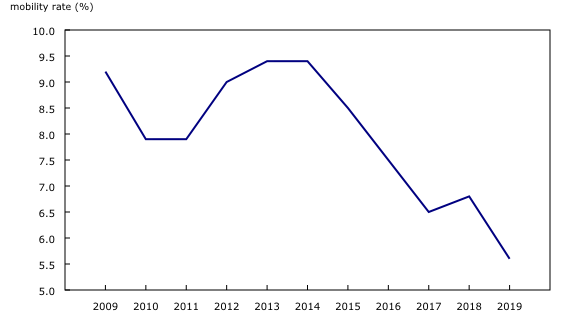Earnings and mobility indicators for newly certified journeypersons in Canada, 2019
Archived Content
Information identified as archived is provided for reference, research or recordkeeping purposes. It is not subject to the Government of Canada Web Standards and has not been altered or updated since it was archived. Please "contact us" to request a format other than those available.
Released: 2022-03-10
Journeypersons who certified in 2018 had a median employment income of $60,450 in 2019, one year after certification. The highest year-over-year growth in median earnings was observed in construction-related trades, such as industrial instrumentation and control technicians (+$7,140) and roofers (+$6,800).
Journeypersons were also less likely than ever before to move to another province or territory in 2019, one year after certification.
Examining the employment income and mobility of journeypersons helps provide a better understanding of the economic environment of the trades in Canada. This release examines the 2019 pre-pandemic earnings and mobility of journeypersons who certified in 2018.
Earnings of journeypersons are highest in the territories and western Canada
The median employment income of journeypersons who certified in 2018 was highest in the territories ($83,700), Alberta ($74,870) and Saskatchewan ($68,390), while median earnings were lowest in Prince Edward Island ($45,790), Quebec ($52,430) and New Brunswick ($56,470). Although western and northern Canada continued to lead the country in median earnings, the gap narrowed from 2018, as the territories (-$1,660) and all three western provinces experienced declines in median employment income. The only provinces to experience growth were in the Atlantic region (+$560) and Quebec (+$2,110).
As many of the higher paying trades are construction-related, shifts in employment and investment in this sector may have impacted the median employment income of journeypersons working in a given province or territory in 2019, compared with the previous year. Alberta (-2.7%), Saskatchewan (-5.4%) and the territories (-0.3%) all experienced drops in construction employment in 2019, while Quebec (+7.2%) and the Atlantic region (+2.5%) experienced growth during the same period. Construction investment showed similar findings, as Alberta (-9.2%) and Saskatchewan (-5.5%) had the largest year-over-year provincial declines compared with 2018, while at the same time Quebec (+8.2%) and the Atlantic region (+7.8%) increased.
The highest growth in median earnings was observed in construction-related trades
By comparing the first year median earnings of journeypersons who certified in 2018, with the first year median earnings of journeypersons who certified the year prior, those in construction-related trades experienced the highest employment income growth. The year-over-year increase in construction investment (+1.3%), employment (+1.8%) and houses under construction (+4.8%) likely contributed to employment income gains for industrial instrumentation and control technicians (+$7,140), roofers (+$6,800), and painter and decorators (+$4,680), all of which experienced growth in median earnings.
Journeypersons who certified as powerline technicians ($118,580), crane operators ($102,560), and industrial instrumentation and control technicians ($101,620) in 2018 had the highest overall median earnings in 2019, one year after certification. Conversely, estheticians ($21,390), hairstylists ($24,140) and landscape horticulturists ($33,930) earned the least.
More female apprentices certified in higher earning trades in 2019
While hairstylist is one of the most common trades of certification for female journeypersons, it is also among the lowest in terms of median employment income. In 2019, fewer female apprentices certified as hairstylists than any year prior, accounting for 32.7% of female certifications compared with 40.9% observed in 2018. The decline in hairstylist certifications, along with a larger portion of female apprentices certifying in higher earning trades, such as carpenters (+0.7%), construction electricians (+0.4%) and industrial mechanics (+0.4%), may lead to higher employment income for female journeypersons in coming years.
Journeypersons are less likely than ever before to move to another province or territory one year after certification
In 2019, one year after being certified, 5.6% of journeypersons either lived or worked in a province or territory other than their jurisdiction of certification. This marks the lowest national mobility rate of journeypersons since the start of the data series in 2008, and a 0.9% decline from the previous lowest rate in 2017.
Alberta continued to be a hub of interprovincial mobility for certified journeypersons in 2019. One year after certification, over one-fifth (21.9%) of journeypersons who either worked or lived in a province other than their province of certification had moved to Alberta. However, at the same time, over one-third (36.6%) of all journeypersons who left their province of certification came from Alberta.
Alberta's struggling economic environment led more journeypersons to migrate out of the province than into the province for the third consecutive year, likely to find employment. However, journeypersons who worked in Alberta one year after certifying experienced the highest median employment income ($74,870) of all provinces, though this was lower than what was seen in the territories.
British Columbia surpassed Alberta in the number of newly certified in-migrants for the first time in 2019. Favourable economic conditions, including growth in construction investment (+7.1%), construction employment (+0.6%) and the lowest unemployment rate (4.7%) in the country, contributed to British Columbia having its lowest mobility rate out of the province (6.7%) since the beginning of series, as well as being the most popular destination for newly certified migrant journeypersons in 2019.
Nova Scotia experienced its highest number of journeypersons migrating to the province in 2019 since the beginning of the series in 2008. This growth stemmed from an increase in newly certified steamfitters/pipefitters and construction electricians migrating to the province from New Brunswick. Nova Scotia also experienced an 11.3% increase in construction investment and a 1.5% growth in construction employment during the same period.
Looking ahead: Earnings and mobility of journeypersons in 2020 likely to be heavily impacted by pandemic
The next release will contain earnings and mobility data for journeypersons in 2020, as the COVID-19 pandemic and corresponding disruptions began to take place. The onset of the pandemic led the provinces and territories to implement guidelines, restrictions and lockdowns that greatly impacted the ability of Canadians to register, certify, and work in the trades. Recently published data showed that new apprenticeship registrations were down by over one-quarter (-28.5%) in 2020, and certifications fell by almost one-third (-32.7%). It is anticipated that the impact of the pandemic on certifications in apprenticeship programs, along with the restrictions on many trade industries and travel during the year, will affect the earnings and mobility of journeypersons in 2020.
Note to readers
Context
This release includes data from the Education and Labour Market Longitudinal Platform, from 2008 to 2019. For more information on the concepts and the methodology used in this study, consult "Earnings indicators for certified journeypersons in Canada, 2008 to 2019" and "Indicators on the interprovincial and territorial mobility of certified journeypersons, 2008 to 2019." Both these articles are part of the publication Technical Reference Guides for the Education and Labour Market Longitudinal Platform (37200001).
Data, definitions and concepts
Earnings indicators were derived at the aggregated level for all trades, and at the disaggregated level for selected trades, including 25 Red Seal trades with the largest number of certifications from 2008 to 2019 and 5 non-Red Seal trades. Four of the five non-Red Seal trades (child and youth worker, developmental services worker, early childhood educator, and educational assistant) are only considered designated trades in Ontario.
Mobility indicators were derived for all trades at the aggregate level and at the trade level for 15 Red Seal trades with the highest number of certifications from 2008 to 2019.
Certification: The requirements for granting a certificate vary by jurisdiction in Canada. In most cases, apprentices are issued a certificate when they fulfill such requirements as supervised on-the-job training, technical training, and by passing one or more examinations. Trade qualifiers, meanwhile, become certified once they pass an examination.
Designated trades: Trades for which apprenticeship training and trade qualifications are available in Canada. These trades are governed by provincial and territorial jurisdictions, which determine the trades for which apprenticeship training is offered and certificates are granted. The jurisdictions also determine which designated trades require certification in order to work unsupervised in the trade.
Journeypersons: Journeypersons are individuals who have completed an apprenticeship program or trade qualifiers who have earned a certificate of qualification.
Registered apprentices: Individuals in a supervised work training program in a designated trade within their provincial or territorial jurisdiction. The apprentice must be registered with the appropriate governing body (usually a ministry of education or labour, or a trade-specific industry governing body).
Trade qualifiers: Individuals who meet the on-the-job experience required to qualify for certification in a jurisdiction, without necessarily having completed an apprenticeship program.
Red Seal program: This program sets common standards to assess the skills of tradespeople across Canada. Journeypersons who meet the Red Seal standards, through examination, receive a Red Seal endorsement on their provincial/territorial trade certificates. There are 54 trades at the national level for which common Red Seal standards are currently available.
Employment income: Includes employment earnings (wages and salaries, commissions from employment, training allowances, tips and gratuities, tax-exempted Indian employment income) and net self-employment income (net income from business, profession, farming, fishing and commissions). It is adjusted for inflation and presented in 2019 constant dollars.
Interprovincial mobility: Interprovincial mobility is calculated by comparing the jurisdiction of certification in a trade, in the Registered Apprenticeship Information System, with the province or territory of residence recorded in the T1 Family File, and the province of employment, obtained from T4 slips, one or three years after certification.
Newly certified journeypersons who live and work in the same province or territory of certification show no interprovincial mobility.
Newly certified journeypersons who live in a different province or territory from the one where they certified are referred to as the "migrant population of journeypersons."
Newly certified journeypersons who work in a different province or territory from their province or territory of residence and certification are referred to as the "shadow population of journeypersons."
Products
The product "Canadian Apprenticeship Longitudinal Indicators" is now available in Statistics Canada – Data Visualization Products (71-607-X).
The infographic "Earning and mobility of journeypersons in Canada, 2019" is now available as part of the series Statistics Canada — Infographics (11-627-M).
New versions of the following technical reference guides are now available: "Indicators on the interprovincial and territorial mobility of certified journeypersons, 2008 to 2019" and "Earnings indicators for certified journeypersons in Canada, 2008 to 2019." Both guides are part of the Technical Reference Guides for the Education and Labour Market Longitudinal Platform (37200001).
Contact information
For more information, or to enquire about the concepts, methods or data quality of this release, contact us (toll-free 1-800-263-1136; 514-283-8300; infostats@statcan.gc.ca) or Media Relations (statcan.mediahotline-ligneinfomedias.statcan@statcan.gc.ca).
- Date modified:




